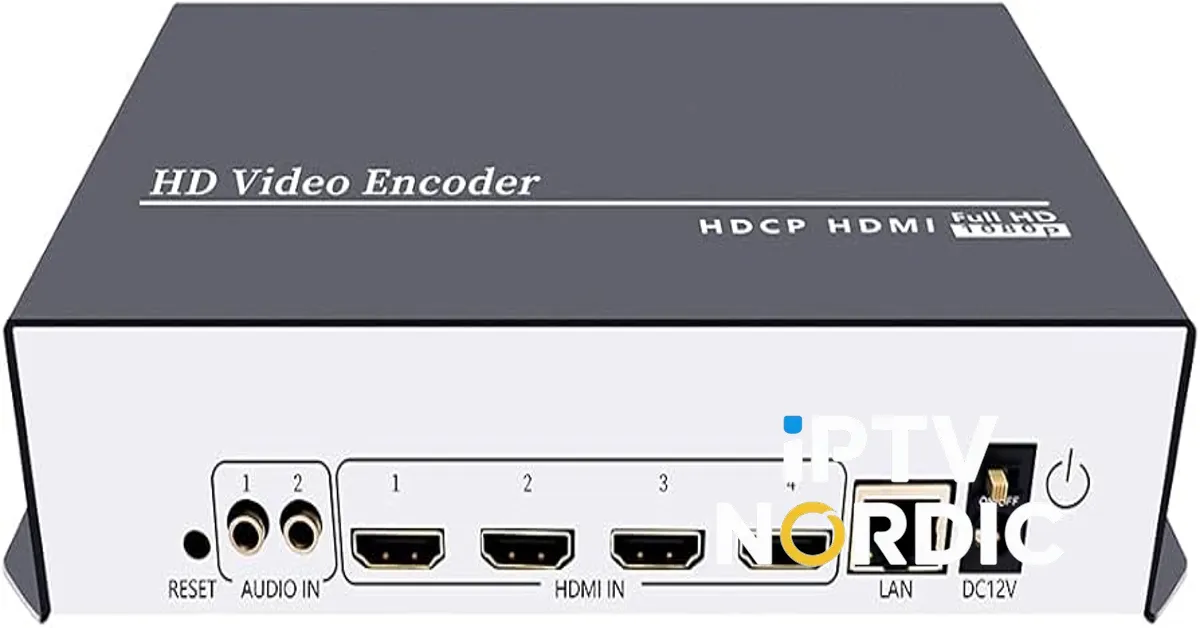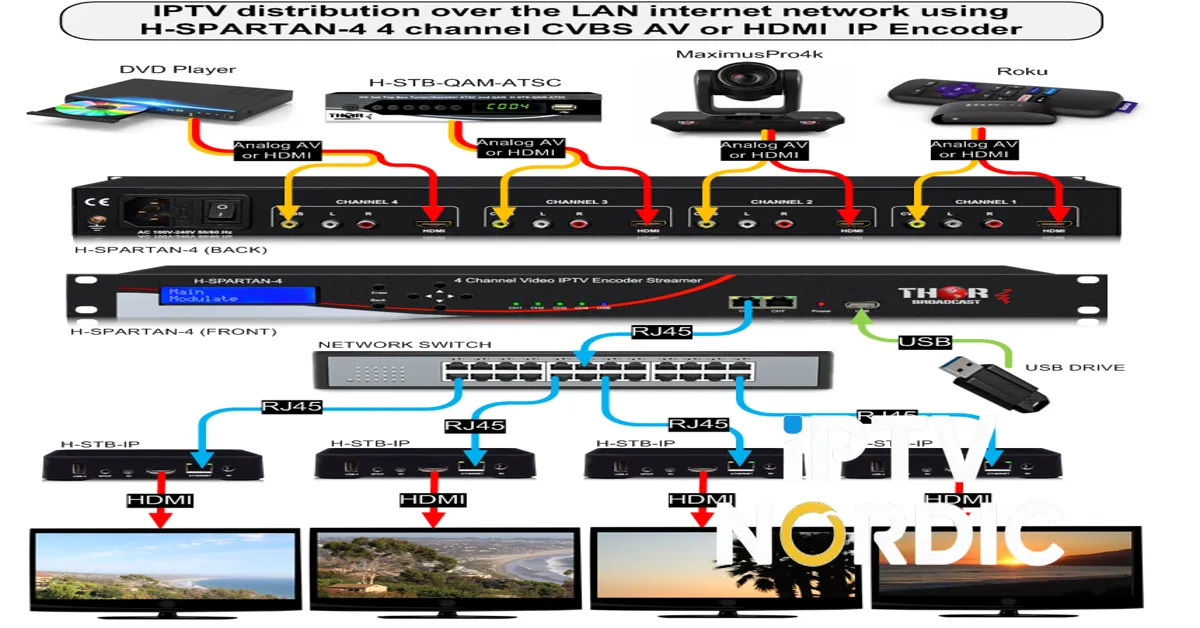HDMI encoder IPTV is a technology that allows users to stream high-definition video content over the internet using an HDMI encoder. This device converts the video signal from an HDMI source, such as a camera or gaming console, into a format that can be easily streamed online.
Using an HDMI encoder for IPTV streaming is essential for maintaining the quality of the video signal during transmission. Without an encoder, the video quality may degrade, leading to a poor viewing experience for the audience. By using an HDMI encoder, content creators can ensure that their videos are delivered in crystal-clear HD resolution.
In this article, we will delve into the importance of using an HDMI encoder for IPTV streaming. We will explore the benefits of this technology, how it works, and provide tips for choosing the right HDMI encoder for your streaming needs. Additionally, we will discuss the various applications of HDMI encoders in different industries. So, let’s dive in and learn more about how HDMI encoders are revolutionizing the world of IPTV streaming.
Understanding HDMI Encoder IPTV
HDMI encoder IPTV refers to a device that converts HDMI video signals into IP-based streams for distribution over an Internet Protocol network. This technology allows users to stream high-definition content from HDMI sources, such as cameras, computers, or set-top boxes, over an IP network.
Features and Capabilities of an HDMI to IPTV Encoder
Low Latency HDMI Encoder
One of the key features of an HDMI encoder for IPTV is its ability to provide low latency streaming. This means that the delay between the input source and the output on the viewer’s screen is minimized, ensuring a smooth viewing experience for real-time applications like live broadcasts or video conferencing.
4K HDMI IPTV Encoder
With the increasing demand for high-resolution content, 4K HDMI IPTV encoders have become essential for delivering ultra-high-definition video over IP networks. These devices can encode and stream content in resolutions up to 4K, providing viewers with crystal-clear images and vibrant colors.
Professional HDMI IPTV Encoder
Professional-grade HDMI IPTV encoders offer advanced features and customization options for users with specific streaming requirements. These devices often include features like multiple input channels, encoding presets, and network management tools to ensure seamless integration into existing IPTV systems.
Benefits of Using HDMI Encoder for IPTV Streaming
Using an HDMI encoder for IPTV streaming offers several benefits, including:
– High-Quality Video: HDMI encoders preserve the quality of the original HDMI source, ensuring that viewers receive crisp and clear video streams.
– Scalability: HDMI IPTV encoders can easily scale to accommodate a growing number of viewers or additional input sources, making them ideal for large-scale streaming applications.
– Flexibility: By converting HDMI signals to IP streams, users can distribute content to a wide range of devices, including smart TVs, computers, and mobile devices, providing a versatile streaming solution.
– Cost-Effectiveness: Implementing an HDMI encoder for IPTV eliminates the need for costly hardware-based distribution systems, reducing overall infrastructure costs.
In conclusion, HDMI encoder IPTV technology plays a crucial role in enabling high-quality, low-latency streaming of HDMI content over IP networks. Whether for live broadcasts, video conferencing, or digital signage, utilizing an HDMI encoder offers a reliable and efficient solution for distributing multimedia content to a broad audience.
How HDMI Encoder Works for IPTV Streaming

In the realm of IPTV streaming, the HDMI encoder plays a crucial role in converting high-definition multimedia interface (HDMI) signals into a format that is compatible with internet protocol television (IPTV) systems. This process involves several steps to ensure seamless transmission of audio and video content over IP networks.
Conversion Process:
When a source device with an HDMI output, such as a set-top box, camera, or gaming console, is connected to an HDMI encoder, the encoder converts the digital HDMI signal into a format suitable for streaming over an IP network. This conversion typically involves compressing the audio and video data to reduce bandwidth requirements while maintaining quality.
Steps Involved:
The HDMI encoder receives the HDMI input signal and processes it using a codec to compress the data. The encoded audio and video streams are then packaged into a suitable format for transmission over an IP network. This packaged data is sent to a streaming server, which distributes the content to viewers accessing the IPTV stream.
Role of HDMI to RTMP Encoder:
One common type of HDMI encoder is the HDMI to RTMP encoder, which converts HDMI signals to Real-Time Messaging Protocol (RTMP) for live streaming over the internet. RTMP is a widely used protocol for delivering audio and video streams, making it ideal for IPTV applications that require low latency and real-time delivery.
Comparison of Encoders:
When choosing an HDMI encoder for IPTV streaming, one may encounter options such as HDMI to H.264 and HDMI to H.265 encoders. The main difference between these encoders lies in the compression algorithms they use. H.264 is a widely supported codec known for its efficiency and compatibility, while H.265 offers higher compression ratios and improved video quality at lower bitrates.
In conclusion, the HDMI encoder serves as a crucial component in the IPTV streaming process, enabling the seamless conversion of HDMI signals into a format suitable for distribution over IP networks. By understanding the steps involved in this conversion process and the role of different encoder types, content providers can choose the right solution to deliver high-quality multimedia content to their viewers.
Choosing the Right HDMI Encoder for IPTV
When it comes to setting up an IPTV system, choosing the right HDMI encoder is crucial for ensuring a smooth streaming experience. There are several key factors to consider when selecting an HDMI encoder for IPTV purposes.
Factors to consider when selecting an HDMI encoder
-
Compatibility with existing systems: One of the most important factors to consider is the compatibility of the HDMI encoder with your existing IPTV infrastructure. Make sure that the encoder can seamlessly integrate with your current setup to avoid any compatibility issues.
-
Video quality and resolution support: Another crucial factor to consider is the video quality and resolution support offered by the HDMI encoder. Look for an encoder that can handle high-definition video to provide your viewers with a top-notch streaming experience.
-
Encoding formats supported: Different HDMI encoders support various encoding formats. Make sure to choose an encoder that supports the formats you need for your IPTV system. Whether you require H.264, H.265, or other formats, ensure that the encoder can meet your specific requirements.
-
Cost and scalability: Consider the cost of the HDMI encoder and ensure that it fits within your budget. Additionally, think about the scalability of the encoder. Will it be able to accommodate future growth in your IPTV system? Choose an encoder that can scale with your needs.
Case studies or examples of successful IPTV HDMI streaming device implementations
One example of a successful IPTV HDMI streaming device implementation is a sports broadcasting company that upgraded its system to include high-quality HDMI encoders. By investing in encoders that supported high-definition video and various encoding formats, the company was able to provide its viewers with an unparalleled streaming experience. The compatibility of the encoders with their existing systems allowed for a seamless integration process. Additionally, the scalability of the encoders ensured that the company could easily expand its IPTV system as needed.
In conclusion, when choosing an HDMI encoder for IPTV, it is essential to consider factors such as compatibility, video quality, encoding formats, cost, and scalability. By carefully evaluating these factors and learning from successful case studies, you can select the right encoder for your IPTV system and provide your viewers with an exceptional streaming experience.
Implementing HDMI Encoder for IPTV Broadcast

In the world of modern broadcasting, the use of IPTV technology has become increasingly popular due to its flexibility, scalability, and cost-effectiveness. One crucial component of an IPTV setup is the HDMI encoder, which allows for the seamless transmission of high-definition video and audio content over an IP network.
Steps to set up and configure an IPTV encoder with HDMI input
Setting up an IPTV encoder with HDMI input may seem like a daunting task, but with the right guidance, it can be a straightforward process. To begin, you will need to connect your HDMI source, such as a camera or video player, to the HDMI input of the encoder. Next, configure the encoder settings to match your desired output resolution and bitrate. Ensure that your network infrastructure can support the bandwidth requirements of the encoded stream. Finally, test the setup to ensure that the video and audio are being transmitted correctly over the IP network.
Best practices for achieving high-quality IPTV broadcasts
Achieving high-quality IPTV broadcasts requires attention to detail and adherence to best practices. To ensure the best possible viewing experience for your audience, it is essential to use a high-quality HDMI encoder that can handle the resolution and bitrate of your content. Additionally, optimize your network settings to minimize latency and packet loss, which can degrade the quality of the stream. Regularly monitor and maintain your equipment to prevent any issues that may impact the broadcast quality.
Using IPTV multicast encoder for efficient distribution
When broadcasting IPTV content to a large audience, using a multicast encoder can significantly improve the efficiency of content distribution. By utilizing multicast technology, a single stream can be sent to multiple viewers simultaneously, reducing network congestion and bandwidth usage. This is especially important for large-scale events or broadcasts where a high number of viewers are expected to tune in. Implementing an IPTV multicast encoder can help ensure a smooth and reliable viewing experience for all viewers.
Integrating HDMI encoder for IPTV headend solutions
Integrating an HDMI encoder into an IPTV headend solution is essential for managing and delivering content to viewers. The headend serves as the central hub where content is received, processed, and distributed to the end-users. By incorporating an HDMI encoder into the headend setup, broadcasters can efficiently encode and stream content from various sources, including live events, pre-recorded videos, and more. This integration allows for seamless content delivery and ensures that viewers receive a high-quality viewing experience.
In conclusion, implementing an HDMI encoder for IPTV broadcast is a crucial step in ensuring the success of your broadcasting efforts. By following the steps outlined above, adhering to best practices, utilizing multicast technology, and integrating the encoder into your headend solution, you can deliver high-quality IPTV content to your audience efficiently and effectively.
Conclusion
In conclusion, the benefits of using an HDMI encoder for IPTV streaming are undeniable. HDMI technology ensures high-quality video and audio transmission, making it ideal for broadcasting content to a wide audience. With HDMI encoders, users can enjoy seamless streaming experiences with minimal latency and excellent picture and sound quality.
Choosing the right HDMI encoder for IPTV is crucial to ensure optimal performance and compatibility with various devices. It is essential to consider factors such as resolution support, encoding capabilities, and connectivity options when selecting an HDMI encoder for IPTV streaming. By choosing the right device, users can enhance their streaming experience and reach a larger audience effectively.
Looking ahead, future trends in HDMI IPTV broadcast solutions are expected to focus on improving efficiency, enhancing video quality, and expanding compatibility with emerging technologies. As the demand for high-quality streaming services continues to grow, HDMI encoders are likely to evolve to meet the needs of users and provide even better streaming experiences in the future. Embracing these trends will be essential for staying competitive in the ever-evolving world of IPTV broadcasting.
Få Premium IPTV-åtkomst
Få tillgång till tusentals kanaler och VOD-innehåll i HD-kvalitet.
Visa Paket